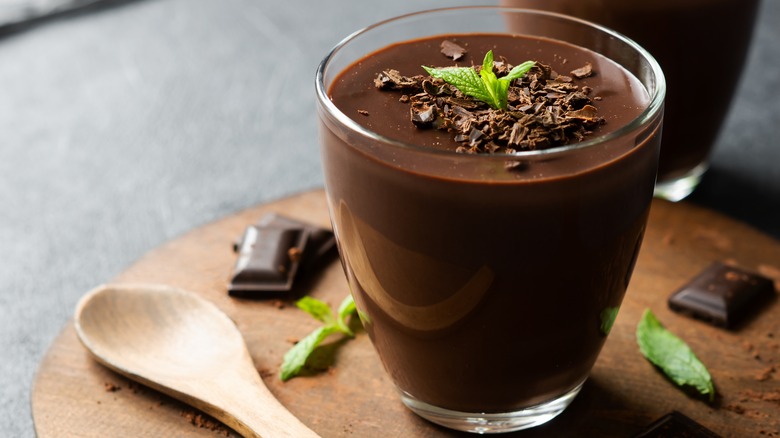Is There Any Actual Difference Between Chocolate Pudding And Budino?
From tiramisu to panna cotta, the Italians know their desserts. While there may not appear to be much difference between an Italian budino and a chocolate pudding, there are subtle features that set these light, creamy desserts apart. The most immediately-noticeable difference is in texture. While pudding's base is made with sugar, cornstarch, and milk, budino is thickened with egg yolks. The richness added by the egg yolks gives budino a sturdier, springier structure. It also makes budino closer to a custard or flan than what you might consider a pudding.
The word "pudding" may translate to "budino" in Italian, but the ingredient equivalent is the biancomangiare — a Sicilian dessert that began as a savory recipe, which Medieval monks would whip up to assist with stomach troubles. The two are also made in the same way, by mixing the ingredients in a pan and cooking until reduced. However, budino is mixed in a mold and cooked in a bain marie, or water bath. A chocolatey variation, biancomangiare al cioccolato, also exists.
The difference between these two sweets is not slight preparation or ingredient variations. If you ask an Italian chef, they're two entirely different dishes. Let's take a look at both the budino and pudding to discover what sets these two delicious desserts apart.
Pudding is as old as the hills
Pudding's origins span centuries and continents. It's believed that the Ancient Romans pioneered the savory pudding, laying the foundations for sausages and the aptly-named black pudding. By the Middle Ages, many European and Asian kitchens were whipping up the sweet variation for use in pies and tarts. Perhaps tellingly, the early European variations included eggs, which may be why the Italian budino continues to use eggs, while the American pudding can be made without them.
Chocolate was popular in European courts as a drink during the 1500s, brought back by Spanish travelers to the Americas, but it didn't find a place in pudding until the 18th century. In 1730, Charles Carter's "The Complete Practical Cook" referenced chocolate pudding in print for the first time. The recipe is packed with spices such as nutmeg, cinnamon, ginger, citron, and orange-flower water, which is unsurprising given chocolate pudding's initial status as a dish for the wealthy. By the 19th century, the cocoa press had been invented, unleashing chocolate upon the world. In America, there was even a genuine push by food companies to promote chocolate pudding as a healthy food for children.
These days, chocolate pudding is seen as a delicious, simple comfort food. It's a great base for extra flavor and trimmings. For example, you could follow Carter and jazz up your pudding with cinnamon or citrus. Vanilla and caramel work if you like sweet instead of spiced. Aesthetically, you can't go wrong with berries and cream!
It took budino a while to arrive on American soil
Budino's history runs parallel with pudding's, with Italians finally landing on "budino" as a term in the 19th century. The name is alleged to have come from the French word "boudin," which in turn came from the English "pudding."
One reason for the variation between the American and Italian recipes could be the availability of cornstarch, which was not present in Italy until the 17th century, by which time budino's recipe was well established. As such, egg yolks have persisted as the thickening agent for budino. In the U.S. press, budino as a distinct recipe was first mentioned circa 1963 by a small California newspaper called San Fernando Valley Living. It was part of a feature on recipes from "foreign lands," implying that, even then, it was clear that Italian budino and American pudding were not the same. At the time, the feature mistakenly identified the dish as Maltese, although it was simply using a Maltese variation.
If you don't specifically order a budino al cioccolato while in an authentic Italian restaurant, you'll be somewhat surprised by what you receive. Budino itself is a custard base that can be infused with just about anything, although some popular flavors are vanilla salted caramel, coffee, and honey. In the summer months, when even caramel can be a bit too much under the heat of the Mediterranean sun, you might find a fruit budino served with berry compote.


